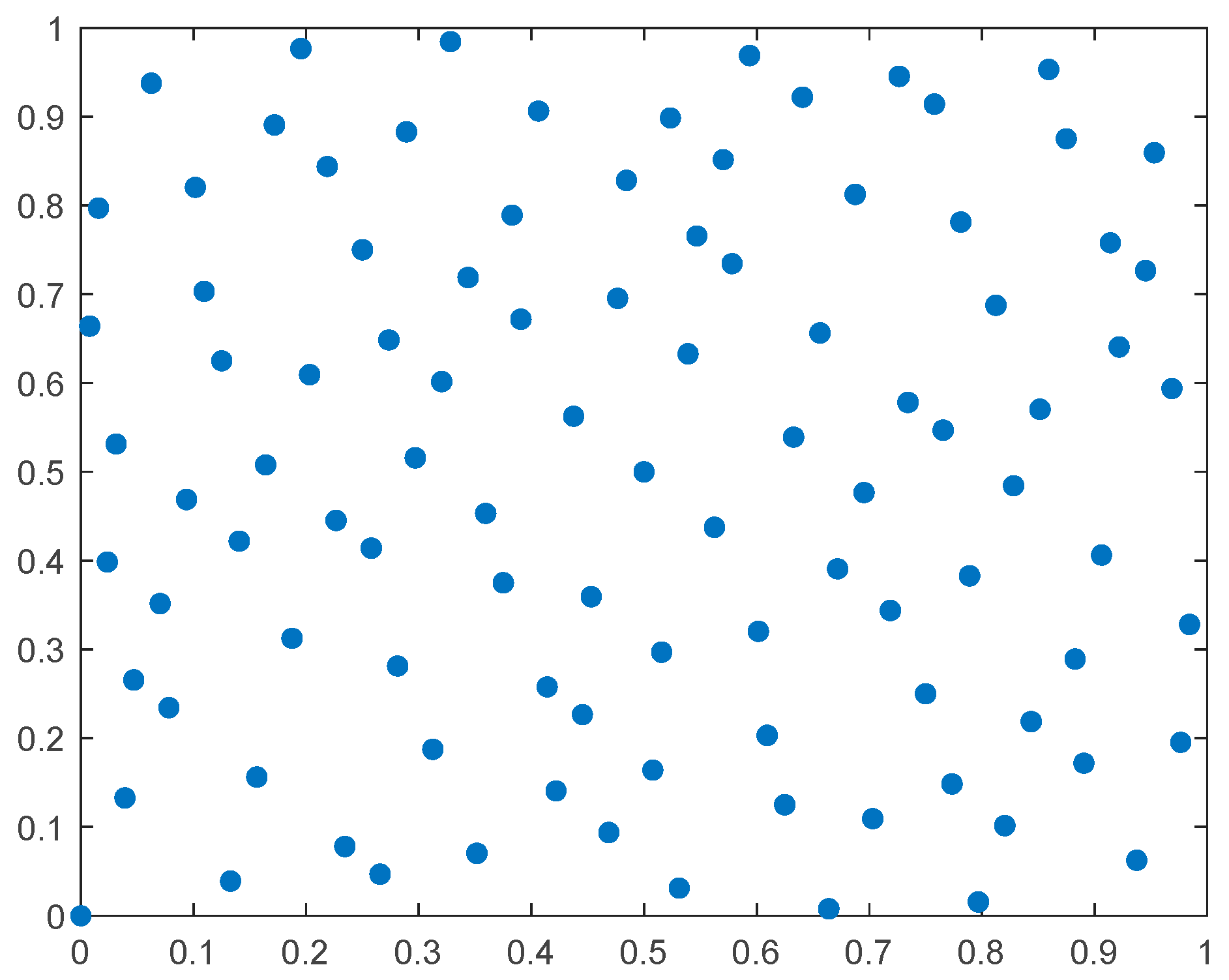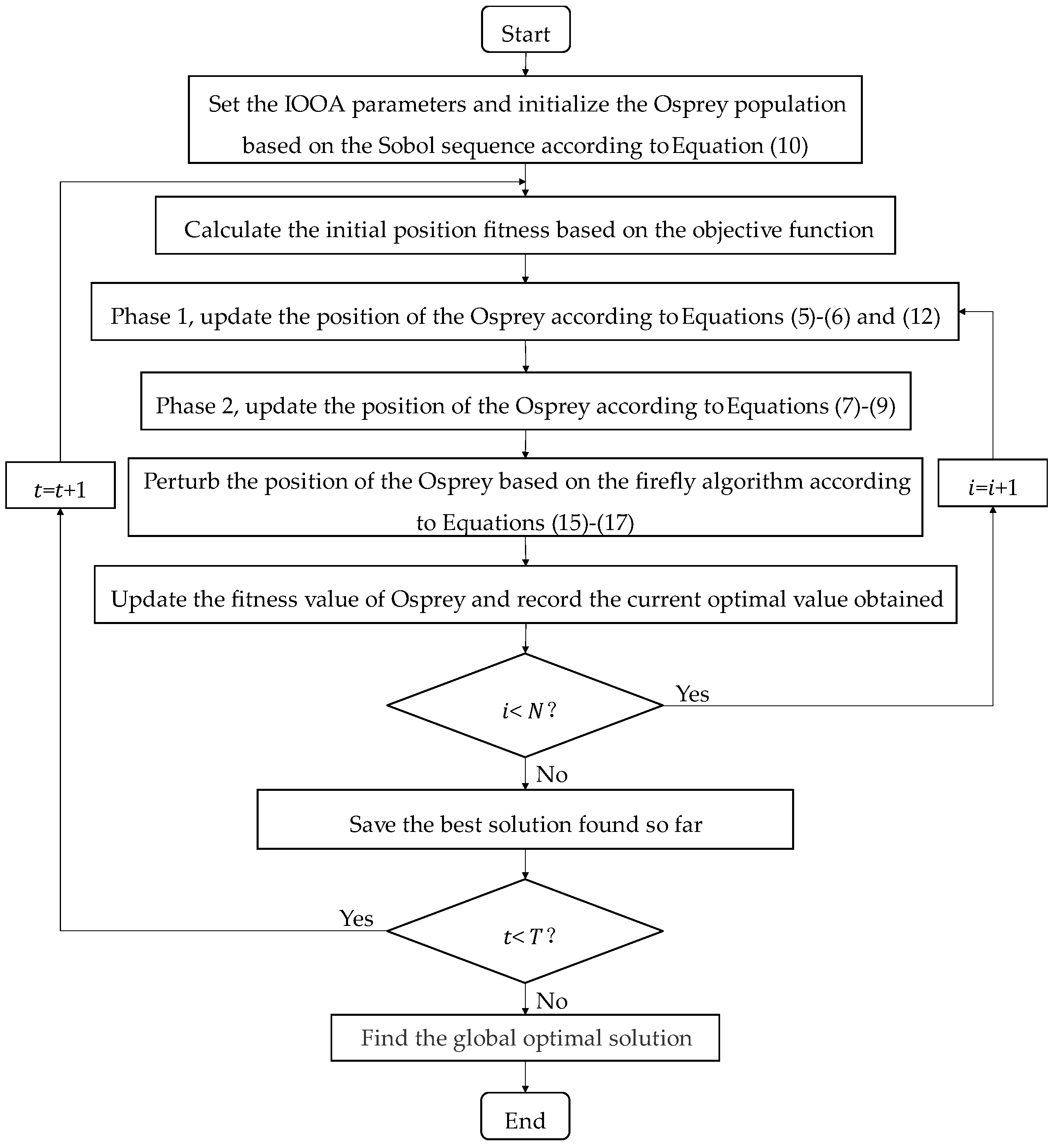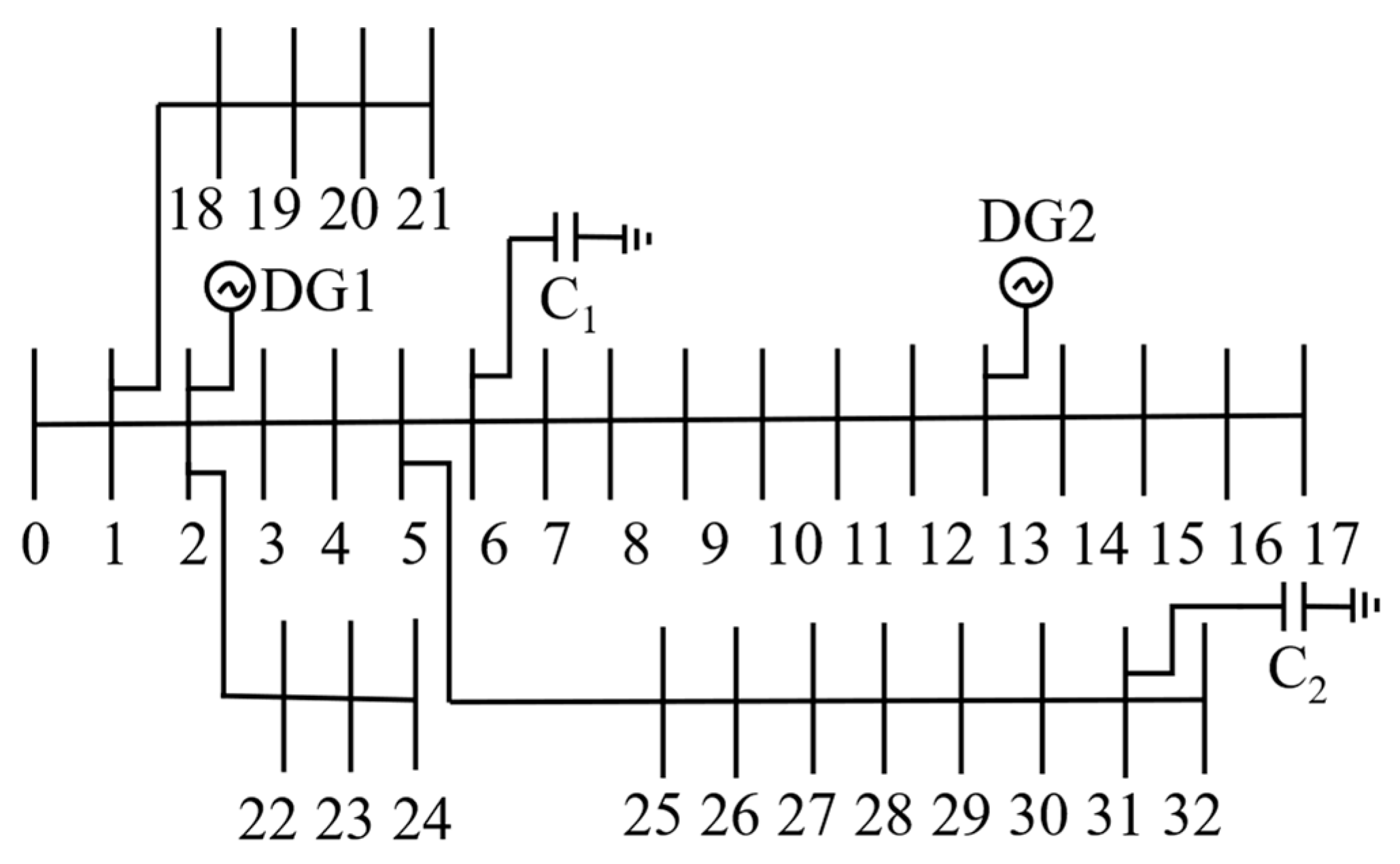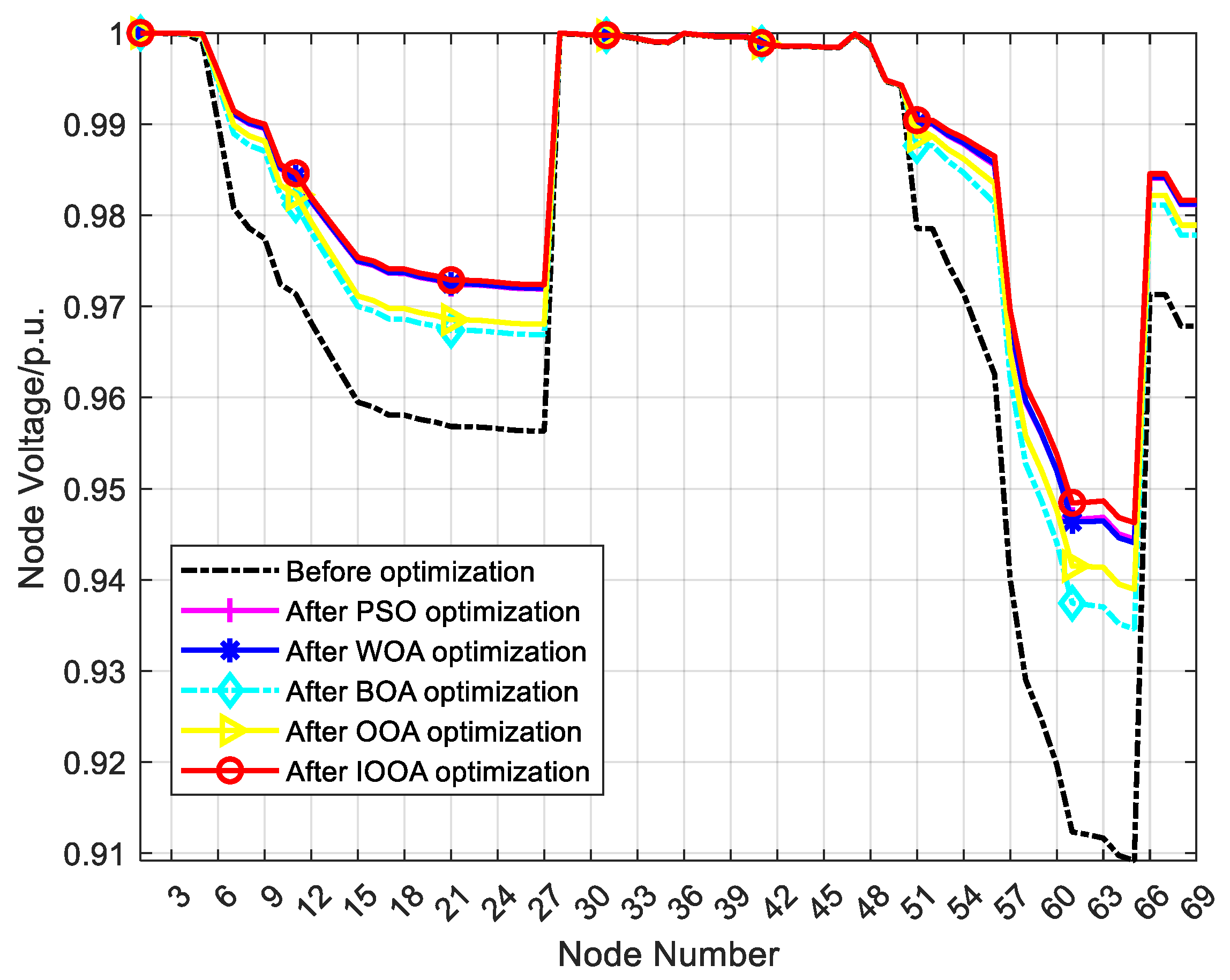1. Introduction
The use of electric energy is a yardstick to measure the development capacity of a country or region. The distributed power generation technologies represented by wind power and optoelectronics have developed rapidly with the proposal of the goal of “carbon peak, carbon neutrality”. The Distributed Generation (DG) has been widely connected to the distribution network in recent years due to the advantages of a clean, renewable, and flexible configuration. However, the randomness of its output also has a significant impact on and challenges the safe and stable operation of the distribution network [
1]. For example, it can cause major problems such as voltage fluctuation and stability reduction in the distribution network [
2]. Therefore, it is important to study the reactive power optimization of distribution networks with DG.
Reactive power optimization is a very challenging problem in power systems. It is designed to ensure efficient and stable operation of the power system by configuring reactive power in the system to improve voltage stability and reduce network losses. Reactive power optimization becomes particularly complex, especially in distribution networks containing DG, because it involves nonlinear programming problems with multiple variables and multiple constraints [
3]. There are various optimization technologies which rationally configure devices, such as distributed power supplies and reactive compensation capacitors in the distribution network [
4]. Many scholars have conducted much of research and exploration into this and have achieved many results over a long time. The methods for solving reactive power optimization problems can be roughly divided into two categories: mathematical optimization methods and intelligent optimization algorithms. The traditional mathematical methods include the linear programming method [
5], nonlinear programming method [
6], simplified gradient method [
7], sequential quadratic programming method [
8], Newton method [
9], interior point method [
10], etc. A second-order cone programming model was established in reference [
11] to transform non-convex optimization problems into convex optimization problems to make more effective use of distributed generation and reduce network losses and voltage fluctuations, and its effectiveness was verified with the IEEE33 system. Each of these methods has certain adaptability and advantages, but the mathematical methods also have great disadvantages, such as not dealing with discrete variables so well, and an easy to fall into the local optimal. Their calculation complexity is high and the time required is long [
12]. Therefore, scholars began to look for more efficient and excellent solutions.
Many intelligent optimization methods have been produced [
13] with the development of continuous exploration of artificial intelligence algorithms. Among them, the swarm intelligent optimization algorithm simulates the behavior processes of evolution and sharing cooperation in nature, and can find the global optimal solution or approximate optimal solution in the complex search space. They can effectively solve complex optimization problems, such as mechanical design optimization [
14], shop scheduling [
15], and device process parameter optimization [
16]. Combined with other methods to solve problems such as model prediction [
17,
18]. Reference [
19] lists the methods combining multi-population intelligent optimization algorithm and machine learning. References [
20,
21,
22], respectively, applied a balance optimizer (EO), the Chimp optimization algorithm (CHOA) and an Archimidian optimizer (AO) to the parameter optimization of neural networks, and all achieved higher accuracy than the prediction model built using only neural networks [
23]. In addition to the above applications, swarm intelligent optimization algorithms are also widely used in reactive power optimization problems.
An increasing number of intelligent optimization algorithms have been applied to reactive power and voltage optimization, such as genetic algorithms [
24], simulated annealing algorithms [
25], particle swarm optimization [
26], immune algorithm [
27], taboo search [
28] algorithm, etc. Many optimization algorithms have been used to solve such problems with the emergence of new intelligent algorithms in recent years. In reference [
29], a multi-objective optimization artificial immune algorithm is used to solve the reactive power optimization problem. In reference [
30], the Particle Swarm Optimization (PSO) is used to solve a power system’s reactive power optimization problem in a particular region, and the practicability of applying PSO is verified. Reference [
31] introduced the whale optimization algorithm inspired by humpback whale bubble-net hunting technology to solve the reactive power optimization problem of a power system and IEEE30-node system. It verified the algorithm’s effectiveness through experiments. Considering the three objectives of active power loss, voltage deviation, and power investment cost, reference [
32] introduces a new multi-objective dragonfly optimization algorithm (MMODA) and compares it with other schemes, demonstrating significant advantages. It can be found that a swarm intelligence optimization algorithm shows a greater advantage when solving a reactive power optimization problem, and increasing research has been conducted in this area. Although many optimization algorithms and improved optimization algorithms have been proposed, the No Free Lunch [
33] (NFL) theorem states that no single optimization algorithm can solve all optimization problems. It is necessary to constantly propose new optimization algorithms and their improved forms to achieve better solutions to optimization problems.
The osprey optimization algorithm [
34] (OOA) is a new swarm intelligent algorithm proposed by Mohammad Dehghani and Pavel Trojovsky in 2023. The osprey is a bird that feeds on many kinds of fish. The osprey will dive underwater to catch fish and bring them to a place it thinks is safe to eat when hunting. The OOA is mainly inspired by the osprey’s predation strategy, which has the characteristics of simple form, easy implementation, and few adjustable parameters. Although the osprey optimization algorithm has carried out a good balance between exploration and development and has good optimization performance, it still has slow convergence problems, quickly falls into local optimal, and has low robustness. However, due to the fact that the Osprey optimization algorithm is a very new swarm intelligence optimization algorithm, there is still limited research on improving the Osprey optimization algorithm, and its aforementioned shortcomings still exist so far.
This paper presents an improved OOA with a population initialization strategy, location update strategy, and increasing disturbance respective. First, population initialization is a critical step in the optimization algorithm, which has an essential impact on the performance and convergence speed of the algorithm. In the OOA, the initialization of the Osprey population is to randomly generate the Osprey population in the search space. However, the initial position of the Osprey generated in this way often lacks ergodicity and is unevenly distributed in the search space. The degree of randomness and uniformity during population initialization will significantly affect the optimization speed and accuracy of the optimization algorithm. Reference [
35] proposes a population initialization strategy based on tent chaos mapping. It is susceptible to the influence of initial parameters and initial conditions, and small changes may produce completely different random sequences, which makes the algorithm’s performance unstable. However, the initialization based on reverse learning [
36] needs to rely on prior knowledge, and the lack of practical prior knowledge may lead to a poor initialization effect and affect the global search ability of the algorithm. The Sobol sequence is a low-difference sequence [
37] with good uniformity and dimensional adaptability unlike the above strategies. Therefore, using it to initialize the population can increase the diversity of the population while making it more likely that the Osprey population is evenly distributed in the search space. This enables the algorithm to quickly find or approach the global optimal solution, accelerate the convergence speed of the algorithm, and thereby reduce computational costs. This paper introduces a population initialization strategy based on the Sobol sequence [
38], which can better avoid the above strategies’ defects and improve the optimization algorithm’s performance. Secondly, we consider the Weibull distribution, a continuous probability distribution, and a heavy-tail distribution [
39] for the position update process. Random numbers subject to Weibull distribution are introduced into the position update phase of the OOA as a step factor, which can increase the exploration of the algorithm in the search space to avoid falling into the local optimal solution. Furthermore, the Weibull step factor may prevent the algorithm from converging prematurely. Finally, a perturbation strategy is added into the algorithm. The Firefly Algorithm (FA) [
40] is a widely used swarm intelligence algorithm inspired by the group behavior of fireflies that flicker and attract each other. It enables fireflies to search widely in the search space. Suppose it is introduced into the OOA through perturbation. The improved method can increase the algorithm’s searchability and make it jump out of the local optimal value more efficiently to avoid algorithm stagnation.
To sum up, we comprehensively improved the performance of the OOA from three aspects and propose an improved osprey optimization algorithm (IOOA). Sobol sequence initialization strategy is used instead of random initialization. The step factor based on Weibull distribution is introduced in updating the position of osprey. The disturbance strategy based on the Firefly Algorithm is introduced to change and disturb the position of the osprey population. The performance of the OOA is comprehensively improved through the above strategies. The experimental results show that the IOOA has faster convergence speeds and accuracy than the compared algorithms when solving most CEC2017 numerical optimization problems. In the practical problem of reactive power optimization of IEEE33 and IEEE69 node distribution network, the IOOA also shows better global optimization ability. The effectiveness and superiority of the proposed IOOA are verified.
The rest of this paper is arranged as follows:
Section 2 introduces the standard osprey optimization algorithm (OOA); in
Section 3, we describe our improved osprey optimization algorithm (IOOA) in detail. In
Section 4, we conduct the experiment and result analysis of the CEC test function and carry out the Wilcoxon rank sum test. In
Section 5, the IOOA is applied to the actual optimization problem of the reactive power optimization of the IEEE33 and IEEE69 node distribution network, and its ability to solve practical problems is tested.
Section 6 is discussion sections and conclusions.

















